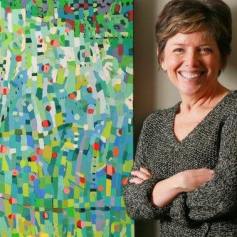Looking at Pictures: Vermeer
Looking at Pictures: Vermeer
See this painting?

You could put it in your purse.
If you are reading this on an iPad or other tablet, keep in mind the painting “Girl with the Red Hat,” at 9” x 7,” is smaller than your screen.
The punch it delivers, however, is closer to the scale of your local Cineplex.
Did I Overdress for This?
Vermeer (aka. Dutch painter of only forty paintings of every day life and light; favorite painter of almost every painter ever) left no sketches for us to pick apart, no students, no writings. What we DO have is…a painting. And a painting, simply, of a woman captured in an instant. Intimate. Immediate.
The subject of a bust portrait in fancy costume was a genre in Dutch painting called tronie. It was reason enough for Vermeer to present a red-feathered serving tray to his model and say, “here, put this on your head.”
In spite of this, I’ve always imagined her in a pub. I have no idea why. That would be some fancy pub furniture. And that is one very fancy be-dazzled hat!
Then, she turns to look at you. And Pop. That moment is stilled forever.
Kitties in Paintings
Much is made of Vermeer’s likely use of the camera obscura (the predecessor to photography) to use lenses and light to replicate an image and aid in painting. Vermeer hung out with scientists and was fascinated by optics. Check out those awesome, oversized lion head finials and the minimal shapes he uses to describe them, including blurry, circular points of light. Just as you might see through a camera lens.

But this moment goes far beyond optics and costumes.
Required Star Wars tie in: The Force
As painters, we know that the force, or power of this painting, comes not from its subject…but in how Vermeer laid down colors and in the genius of his essential abstraction.
The abstraction is at the heart of good painting. I’m still figuring this out in my own painting. But I know it when I see it in Vermeer. Squint your eyes (never heard that before, right?) to see the big shapes and the perfect balance of the arrangement. The ice white kerchief anchors the little spots together into a tidy triangle.
If we could hold this little gem in our hands, (museums discourage, but whatever), we would see, for the cloak, the artist prepares us for the subplot of his story by laying down a thin, reddish brown veil of paint. He layers over this with glazes of ultramarine (read more about your go-to cool color here).

This gives the blue warmth and complexity. Over that, is a bit more saturated blue, with a bit of white in it. Then, on top, comes the (what?) yellow-white ABSTRACT shapes of light. Look. They are rather geometric…placed in the perfect arrangement of sizes, shapes. Heading this way and that. In different sizes.

The same thing happens in her face. The face, though in shadow, is intensely warm. We understand that there must be a glow from that crazy hat, but he makes those tones glow with the green he uses just around it. Vermeer is painting most of the painting thinly, glazing over layers. It is the slow build up to the climax of his story, applied with heftier paint.
He makes the red hat a crescendo (oops. slipping from literary analogies to musical ones but you get it, don’t you?) against a muted colored tapestry. But check out the shapes there. The pattern of the 3 shapes behind her head. The direction of the curves. They, too, get to play a part in the larger story (okay back to literary).
The dot

Now the story has gotten me so excited I can barely mention about the dot of light in her eye. Get in close. I swear to you. It is turquoise. A little tourquoise dot.
Who does that?
Johannes Vermeer c. 1615-1666
Oil on panel (9.1 in x 7.1 in) National Gallery of Art, Washington DC
 Jean Cauthen is a Painter and fake Art Historian. She has a studio in Charlotte NC. Her painting workshops in Italy always include a “Gelato and Art History” tour of Rome, Italy where she asks that participants keep any discrepancies to themselves and focus on the gelato. Click here to learn more about Jean.
Jean Cauthen is a Painter and fake Art Historian. She has a studio in Charlotte NC. Her painting workshops in Italy always include a “Gelato and Art History” tour of Rome, Italy where she asks that participants keep any discrepancies to themselves and focus on the gelato. Click here to learn more about Jean.



Hi Amazing Post!!! I like this website so much it's really awesome. Nice information About PAINTING CLASSES IN CHENNAI.Thanks for sharing good information with beautiful images.I hope you will be posting more like this beautiful posts.
ReplyDeleteAll the best
I love seeing paintings thanks for sharing such a beautiful painting. I was searching for such kind of painting, and then I found them on fanusta global. They have wide range of paintings and much more. Keep sharing.
ReplyDelete